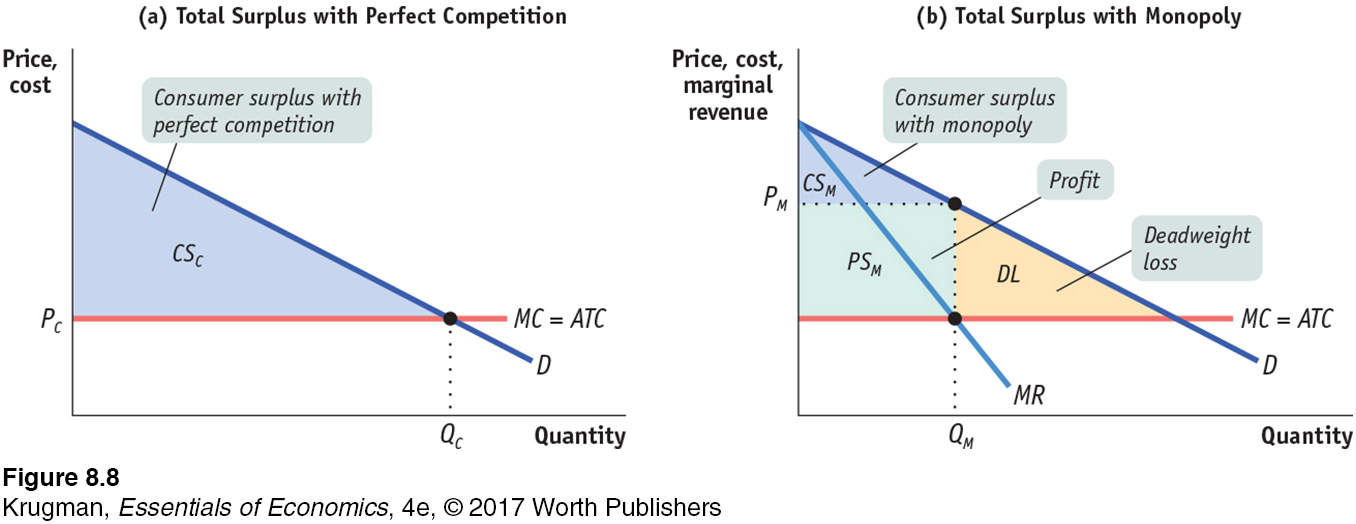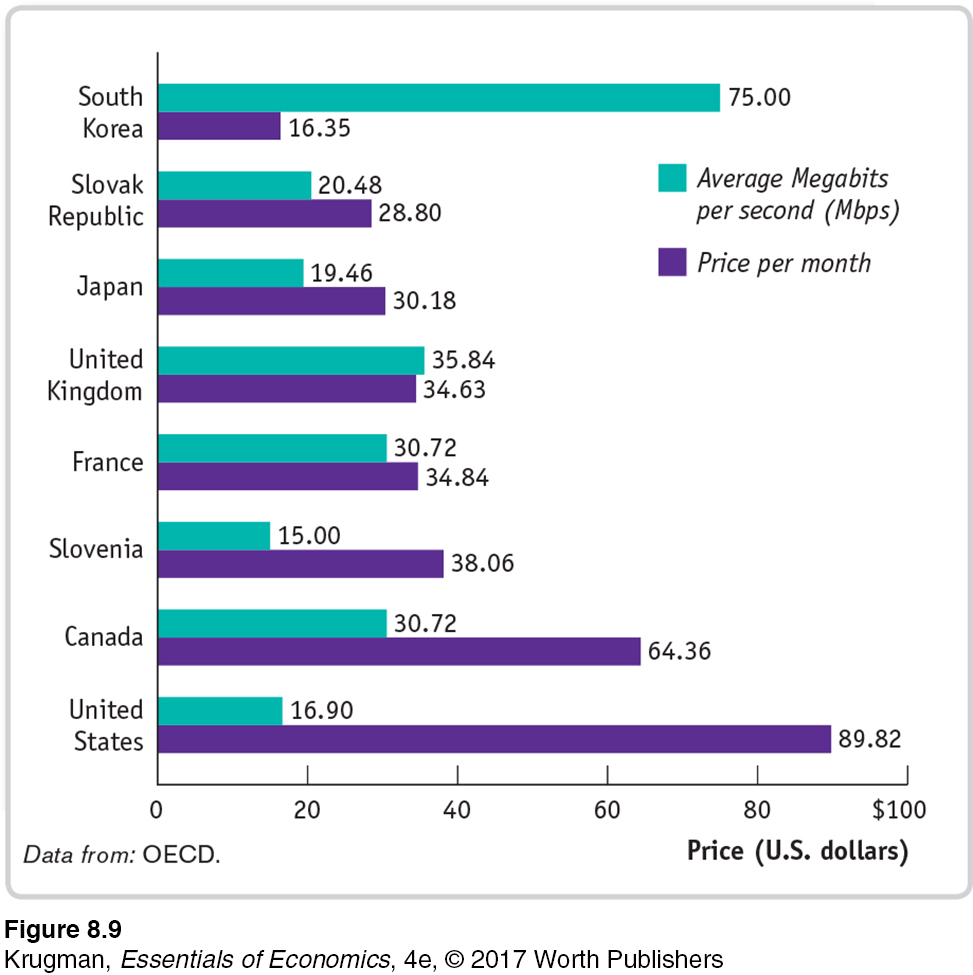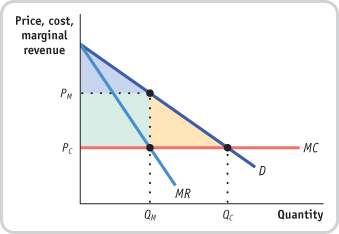8.4 Monopoly and Public Policy
It’s good to be a monopolist, but it’s not so good to be a monopolist’s customer. A monopolist, by reducing output and raising prices, benefits at the expense of consumers. But buyers and sellers always have conflicting interests. Is the conflict of interest under monopoly any different than it is under perfect competition?
The answer is yes, because monopoly is a source of inefficiency: the losses to consumers from monopoly behavior are larger than the gains to the monopolist. Because monopoly leads to net losses for the economy, governments often try either to prevent the emergence of monopolies or to limit their effects. In this section, we will see why monopoly leads to inefficiency and examine the policies governments adopt in an attempt to prevent this inefficiency.
Welfare Effects of Monopoly
By restricting output below the level at which marginal cost is equal to the market price, a monopolist increases its profit but hurts consumers. To assess whether this is a net benefit or loss to society, we must compare the monopolist’s gain in profit to the loss in consumer surplus. And what we learn is that the loss in consumer surplus is larger than the monopolist’s gain. Monopoly causes a net loss for society.
To see why, let’s return to the case where the marginal cost curve is horizontal, as shown in the two panels of Figure 8-8. Here the marginal cost curve is MC, the demand curve is D, and, in panel (b), the marginal revenue curve is MR.

Panel (a) shows what happens if this industry is perfectly competitive. Equilibrium output is QC; the price of the good, PC, is equal to marginal cost, and marginal cost is also equal to average total cost because there is no fixed cost and marginal cost is constant. Each firm is earning exactly its average total cost per unit of output, so there is no profit and no producer surplus in this equilibrium.
The consumer surplus generated by the market is equal to the area of the blue-
Panel (b) shows the results for the same market, but this time assuming that the industry is a monopoly. The monopolist produces the level of output QM, at which marginal cost is equal to marginal revenue, and it charges the price PM. The industry now earns profit—
By comparing panels (a) and (b), we see that in addition to the redistribution of surplus from consumers to the monopolist, another important change has occurred: the sum of profit and consumer surplus—
This net loss arises because some mutually beneficial transactions do not occur. There are people for whom an additional unit of the good is worth more than the marginal cost of producing it but who don’t consume it because they are not willing to pay PM.
If you recall our discussion of the deadweight loss from taxes you will notice that the deadweight loss from monopoly looks quite similar. Indeed, by driving a wedge between price and marginal cost, monopoly acts much like a tax on consumers and produces the same kind of inefficiency.
So monopoly hurts the welfare of society as a whole and is a source of market failure. Is there anything government policy can do about it?
Preventing Monopoly
Policy toward monopoly depends crucially on whether or not the industry in question is a natural monopoly, one in which increasing returns to scale ensure that a bigger producer has lower average total cost. If the industry is not a natural monopoly, the best policy is to prevent monopoly from arising or break it up if it already exists. Let’s focus on that case first, then turn to the more difficult problem of dealing with natural monopoly.
The De Beers monopoly on diamonds didn’t have to happen. Diamond production is not a natural monopoly: the industry’s costs would be no higher if it consisted of a number of independent, competing producers (as is the case, for example, in gold production).
So if the South African government had been worried about how a monopoly would have affected consumers, it could have blocked Cecil Rhodes in his drive to dominate the industry or broken up his monopoly after the fact. Today, governments often try to prevent monopolies from forming and break up existing ones.
De Beers is a rather unique case. For complicated historical reasons, it was allowed to remain a monopoly. But over the last century, most similar monopolies have been broken up. The most celebrated example in the United States is Standard Oil, founded by John D. Rockefeller in 1870. By 1878 Standard Oil controlled almost all U.S. oil refining; but in 1911 a court order broke the company into a number of smaller units, including the companies that later became Exxon and Mobil (and more recently merged to become ExxonMobil).
The government policies used to prevent or eliminate monopolies are known as antitrust policies, which we will discuss in the next chapter.
Dealing with Natural Monopoly
Breaking up a monopoly that isn’t natural is clearly a good idea: the gains to consumers outweigh the loss to the producer. But it’s not so clear whether a natural monopoly, one in which a large producer has lower average total costs than small producers, should be broken up, because this would raise average total cost. For example, a town government that tried to prevent a single company from dominating local gas supply—
Yet even in the case of a natural monopoly, a profit-
What can public policy do about this? There are two common answers.
In public ownership of a monopoly, the good is supplied by the government or by a firm owned by the government.
1. Public Ownership In many countries, the preferred answer to the problem of natural monopoly has been public ownership. Instead of allowing a private monopolist to control an industry, the government establishes a public agency to provide the good and protect consumers’ interests.
Some examples of public ownership in the United States include passenger rail service, which is provided by the public company Amtrak; regular mail delivery, which is provided by the U.S. Postal Service; and in some cities, including Los Angeles, there are publicly owned electric power companies.
The advantage of public ownership, in principle, is that a publicly owned natural monopoly can set prices based on the criterion of efficiency rather than profit maximization. In a perfectly competitive industry, profit-
Experience suggests, however, that public ownership as a solution to the problem of natural monopoly often works badly in practice. One reason is that publicly owned firms are often less eager than private companies to keep costs down or offer high-
Price regulation limits the price that a monopolist is allowed to charge.
2. Regulation In the United States, the more common answer has been to leave the industry in private hands but subject it to regulation. In particular, most local utilities like electricity and natural gas, are covered by price regulation that limits the prices they can charge.
We saw in Chapter 4 that imposing a price ceiling on a competitive industry is a recipe for shortages, black markets, and other nasty side effects. Doesn’t imposing a limit on the price that, say, a local gas company can charge have the same effects?
Not necessarily: a price ceiling on a monopolist need not create a shortage—
The upcoming Economics in Action describes the case of broadband, a natural monopoly that has been alternately regulated and deregulated as politicians change their minds about the appropriate policy.
A monopsony exists when there is only one buyer of a good. A monopsonist is a firm that is the sole buyer in a market.
Monopsony It is possible to have a market in which there is only one buyer and many sellers, so that the buyer can use its power to capture surplus from the sellers. That market is called a monopsony.
Like a monopolist, a monopsonist will distort the competitive market outcome in order to capture more of the surplus, except that the monopsonist will do this through quantity purchased and price paid for goods rather than through quantity sold and price charged for goods.
Monopsony, although it does exist, is rarer than monopoly. The classic example is a single employer in a small town—
Just as a monopolist creates a deadweight loss by producing too little of the output, a monopsonist creates a deadweight loss by hiring too few workers (and thereby producing too little output as well).
Monopsony seems to occur most frequently in markets in which workers have a specialized skill, and there is only one employer who hires based on that skill. For example, physicians have often complained that in some parts of the country where most patients are insured by one or two insurance companies, the companies act as monopsonists in setting the reimbursement rates they pay for medical procedures.
What to Do About Monopoly? Managing monopoly (and monopsony) can be tricky because trade-
In the case of a regulated natural monopoly like power generation, how can power producers invest in cost-
Economists and policy makers have struggled with these questions for decades because the best answer is often found through trial and error—
ECONOMICS in Action
Why Is Your Broadband So Slow? And Why Does It Cost So Much?
 | interactive activity
| interactive activity
Consider this: In the United States, high-

Why do we pay so much? Many observers conclude that the United States has been especially bad at regulating the cable companies that provide broadband to more than two-
However, a decade ago Congress deregulated high-
It should come as no surprise, then, that consumers also face yearly price hikes: from 1995 to 2012, the average price of a basic cable subscription increased at an annual rate of more than 6%. In the few locations where there are competing cable companies, bills are typically 15% lower and service is better.
But how did broadband consumers in other countries escape that same fate, given that cable is a natural monopoly? Regulators imposed a common carriage rule on their industries, stipulating that cable companies must rent their cable capacity to internet service providers, who then compete to deliver internet access to consumers.
Without such a rule, the vast majority of Americans—
Quick Review
By reducing output and raising price above marginal cost, a monopolist captures some of the consumer surplus as profit and causes deadweight loss. To avoid deadweight loss, government policy attempts to curtail monopoly behavior.
When monopolies are “created” rather than natural, governments should act to prevent them from forming and break up existing ones.
Natural monopoly poses a harder policy problem. One answer is public ownership, but publicly owned companies are often poorly run.
A common response in the United States is price regulation. A price ceiling imposed on a monopolist does not create shortages as long as it is not set too low.
There always remains the option of doing nothing; monopoly is a bad thing, but the cure may be worse than the disease.
A monopsony, when there is only one buyer of a good, also results in deadweight loss. The monopsonist can affect the price of the good it buys: it captures surplus from sellers by reducing how much it purchases and thereby lowers the price.
Check Your Understanding 8-3
Question 8.6
1. What policy should the government adopt in the following cases? Explain.
Internet service in Anytown, Ohio, is provided by cable. Customers feel they are being overcharged, but the cable company claims it must charge prices that let it recover the costs of laying cable.
Cable Internet service is a natural monopoly. So the government should intervene only if it believes that price exceeds average total cost, where average total cost is based on the cost of laying the cable. In this case it should impose a price ceiling equal to average total cost. Otherwise, it should do nothing.
The only two airlines that currently fly to Alaska need government approval to merge. Other airlines wish to fly to Alaska but need government-
allocated landing slots to do so. The government should approve the merger only if it fosters competition by transferring some of the company’s landing slots to another, competing airline.
Question 8.7
2. True or false? Explain your answer.
Society’s welfare is lower under monopoly because some consumer surplus is transformed into profit for the monopolist.
False. As can be seen from Figure 8-8, panel (b), the inefficiency arises from the fact that some of the consumer surplus is transformed into deadweight loss (the yellow area), not that it is transformed into profit (the green area).
A monopolist causes inefficiency because there are consumers who are willing to pay a price greater than or equal to marginal cost but less than the monopoly price.
True. If a monopolist sold to all customers who have a valuation greater than or equal to marginal cost, all mutually beneficial transactions would occur and there would be no deadweight loss.
Question 8.8
3. Suppose a monopolist mistakenly believes that its marginal revenue is always equal to the market price. Assuming constant marginal cost and no fixed cost, draw a diagram comparing the level of profit, consumer surplus, total surplus, and deadweight loss for this misguided monopolist compared to a smart monopolist.
As shown in the accompanying diagram, a profit-

Solutions appear at back of book.